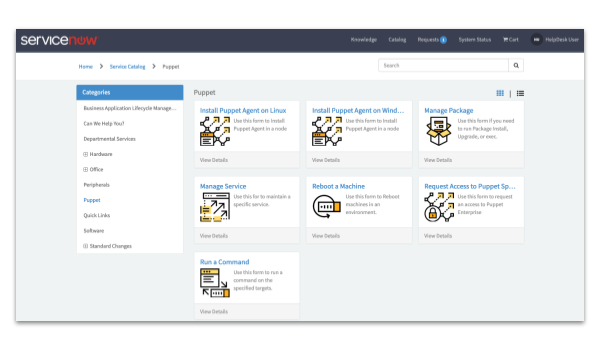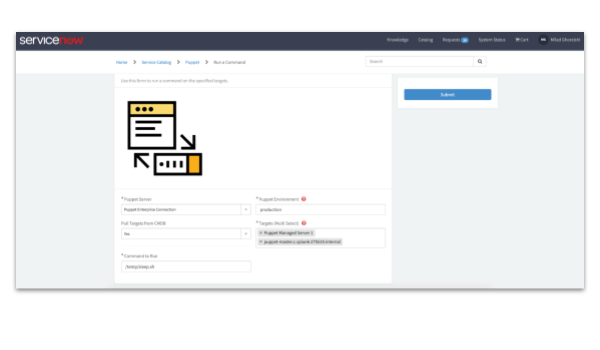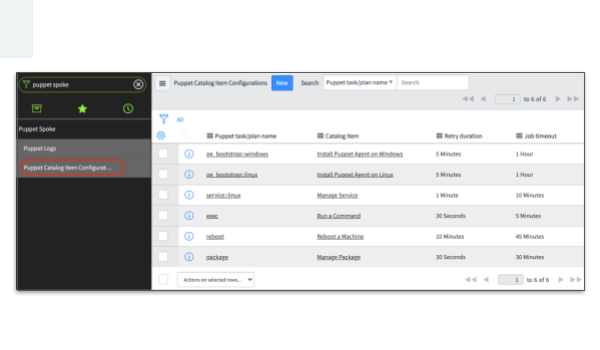Blog
May 18, 2021
Accelerate Operational Tasks with Puppet and ServiceNow Spokes
Products & Services,
Ecosystems & Integrations
Get an overview of a new integration available for you from Puppet and ServiceNow in this blog.
Table of Contents:
- What is Puppet Spoke for ServiceNow?
- Benefits of Puppet Spoke (a ServiceNow Spoke)
- ServiceNow Integrations You Can Use
What is Puppet Spoke for ServiceNow?
Puppet Spoke is one of the latest ServiceNow spokes.
As your DevOps and IT Service Management (ITSM) teams continue to increase, so should your ability to provide self-service infrastructure capabilities. Whether you are a ServiceNow or Puppet administrator looking to expand automation to other groups such as Site Reliability Engineering or the IT Service Desk, the integration of Puppet Enterprise and ServiceNow is now at your fingertips.
We are excited to announce the availability of the Puppet Spoke, a new certified integration available on the ServiceNow store that gives I&O and DevOps teams self-service workflows to manage Puppet assets directly from ServiceNow’s Service Catalog Request Portal. In this post, we’ll highlight how this integration benefits organizations that use Puppet and ServiceNow today, provide a few examples of how it’s used, and share why it’s essential to have in your organization.
Benefits of Puppet Spoke (a ServiceNow Spoke)
Take Action With Self-Service Workflows
Without automation, executing changes can lead to manual updates, painful email threads with lost context, reliance on a single expert, and potential human error, all of which can jeopardize and delay crucial business activity. With Puppet Spoke, teams that require action on Puppet-managed infrastructure but rely on other teams now have access to simplified workflows that trigger Puppet actions from a single, known interface from the ServiceNow portal.
You can easily manage a package or service, run a command, reboot a machine, and install the Puppet Agent directly from the ServiceNow catalog. Additionally, teams can customize and add workflows to the catalog based on Puppet tasks and plans commonly used within your organization. You get Puppet’s data and action engine all from within the same organization-wide platform of ServiceNow.
Consistent Operations and Processes
Requests driven through ServiceNow offer a unified platform to track, automate and increase visibility into actions performed across the organization. This leads to less risk and automatically documents changes. Additionally, for those teams responsible for managing the change process and who have specific KPIs to measure change success and failure rates, the advantage of self-service workflows is consistent, repeatable actions through standard processes. The ITIL framework is still in place, but without the perceived pain of non-standard change requests. Everyone wins! The Puppet Spoke integration follows the underlying standard change management processes while offering a seamless experience from an end user perspective.
Self-Service Workflows in Action
Getting started is simple. Navigate to Service Catalog in ServiceNow Service Portal, and select the Puppet category (visible only to ITIL users). The integration comes out of the box with some of the most commonly used tasks and are available for use right away. Custom workflows can be created using the Puppet Spoke as well. The available self-service workflows include:
- Install puppet agent - install Puppet Agent in a node.
- Manage package - run Package Install, Upgrade, or exec.
- Manage service - maintain a specific service.
- Reboot a machine - reboot machines in an environment.
- Request puppet access - request access to Puppet Enterprise.
- Run a command - run a command on the specified targets.

By default, “Request puppet access” is the only visible item to ITIL users. Users need to submit a “Request puppet access” form that requires manager approval to see all the other catalog items in the Puppet category, as shown above.
As an example, in order to run a command in Puppet, a user needs to submit the Run a Command catalog item:
Puppet Server - choose the Puppet Server Puppet Environment - choose the Puppet environment you want this command to run on Pull Target from CMDB - yes/no- Targets - When “Pull target from CMDB” option is set to “Yes” you can select items from the Servers table in the CMDB here. If the option is set to “No” this field becomes a plain text field where you can specify the FQDNs of your targets.
Command to Run - run any command to take action
A Request item (RITMxxxxxxx) gets created after the form is submitted. A job gets created in Puppet Enterprise related to this request, and the job result will be updated in the RITM after it is finished or failed in Puppet Enterprise.
Each form is configurable via the ServiceNow Puppet Catalog Item Configuration form where you match the Puppet task details, retry duration (how frequent to poll Puppet Enterprise for status updates), and job timeout (when to stop polling Puppet Enterprise if no final result was reached yet) to the catalog item.

ServiceNow Spoke Integrations You Can Use
A seamless integration, Puppet Spoke, enables customers of both Puppet and ServiceNow to take self-service actions on Puppet-managed infrastructure directly from ServiceNow. Teams have the advantage of delivering software releases faster and more frequently while ensuring the IT management and operations are still processed in a way that meets business standards.
With Puppet professional services, a Puppet expert can help integrate and customize your Puppet Spoke integration, or enable any other ServiceNow and Puppet use case.
Download Puppet Spoke Today
- Download the Puppet Spoke from the ServiceNow Store.
- Learn how to get started with the Puppet Spoke installation guide.
- Read the ebook on the benefits of using Puppet and ServiceNow.
- Interested in other integrations? Learn about the Service Graph Connector.
- Download the Solution Brief with an overview of ServiceNow Spoke Integration.
Not Using Puppet Enterprise Yet?
Get started with your free trial.

